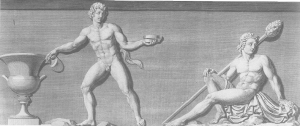Spencer House in London
Spencer House was built in the mid 18th century by John Vardy for the first Earl Spencer, a member of the Society of Dilettanti - those who as young men had made the Grand Tour and later built and decorated their houses in classical taste.
The ground floor by Vardy uses numerous motifs from Roman architecture, whereas the first floor designed later by “Athenian” Stuart introduces Greek motifs.
The west façade opens on to Green Park.
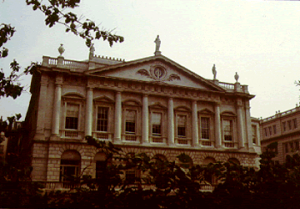
- Spencer House
- [click on the picture to enlarge it]
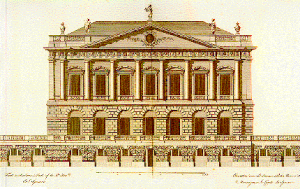
- Spencer House
- West elevation published in Vitruvius Britannicus (1767)
[click on the picture to enlarge it]
The Roman floor
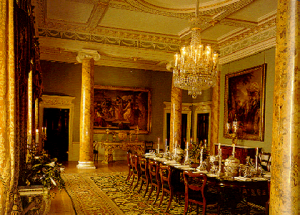
- The Dining Room
- [click on the picture to enlarge it]
The ground floor was decorated by John Vardy, who borrowed Roman motifs.
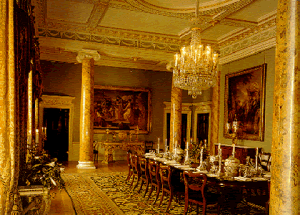
- The Dining Room
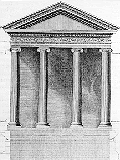
- Temple of Fortuna Virilis
The frieze above the Ionic columns is imitated from the Temple of Fortuna Virilis in Rome, as illustrated in Les Edifices antiques de Rome by Desgodetz (1682).
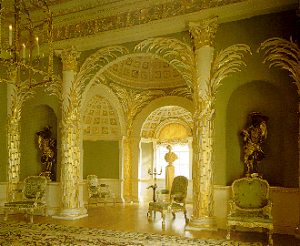
- The Palm Room
- [click on the picture to enlarge it]
The Palm Room on the ground floor has columns suggesting the natural origin of architectural elements.
The frieze is imitated from a temple on the Forum.
The Greek floor
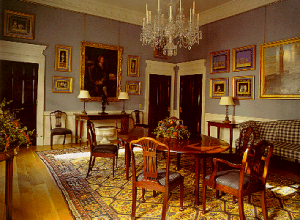
- The Music Room
- [click on the picture to enlarge it]
The first floor was built from 1758 onwards, after “Athenian” Stuart’s return from Greece, and it uses Greek motifs or themes from recent archaeology.
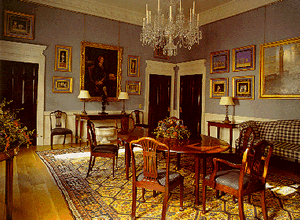
- The Music Room
- [click on the picture to enlarge it]
The Music Room is decorated with engravings handcoloured in gouache reproducing the decorations of the Golden House in Rome. The discovery of Pompei (1758) increased the amateurs’ interest in the rare relics of Ancient painting such as Pompeian frescoes and Roman wallpaintings, since they were the only surviving imitations of lost Greek paintings mentioned in classical texts. They were also examples of the use of colour by the Ancients, and it made it necessary to adapt the traditional medium of engraving hitherto used for architectural views: each print was handcoloured after printing - the classical inspiration was no longer a matter of shades of grey, it acquired colour.
It also has Hellenistic ornaments.
The Dancing Faun, a miniature bronze replica at Spencer House, and its marble original which can be seen in Zoffany’s painting of the Tribuna of the Uffizi.
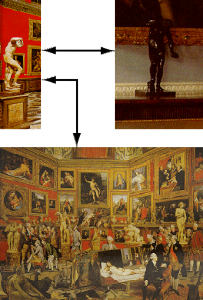
- The Tribuna of the Uffizi
- The Tribuna of the Uffizi by Zoffany (1770s)
The Royal Collection by Reynolds
[click on the picture to enlarge it]

- The Music Room
- [click on the picture to enlarge it]
The bronze on the table is a miniature copy of the Dancing Faun, a Hellenistic sculpture in Zoffany’s painting of the Tribuna of the Uffizi in Florence existing in numerous versions and much loved by travellers.
by Reynolds Garrick and his wife (1773, National Portrait Gallery)
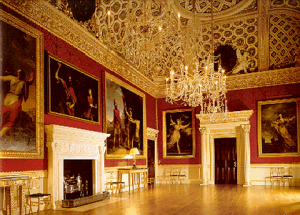
- The Great Room
- [click on the picture to enlarge it]
Its ornementation is of Greek inspiration.
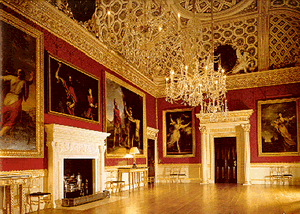
- The Great Room
- [click on the picture to enlarge it]
The chimneypiece has a frieze copied from the Choragic Monument of Lysicrates in Athens, as illustrated in Stuart’s Antiquities of Athens (1762).

